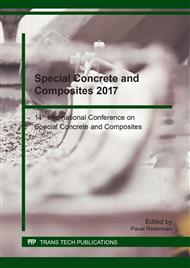[1]
A. Moroupolou, A.S. Cakmak, G. Biscontin, A. Bakolas and E. Zendri, Advanced Byzantine cement based composites resisting earthquakestresses: the crushed brick/lime mortars of Justinian's Hagia Sophia, Constructionand Building Materials. 16(8) (2002).
DOI: 10.1016/s0950-0618(02)00005-3
Google Scholar
[2]
C. Rodriguez-Navarro, E. Ruiz-Agudo, E. Ortega-Huertas, E. Hansen, Nanostructure and irreversible colloidal behavior of Ca(OH)2: implications incultural heritage conservation. Langmuir 21 (2005) p.10948–10957.
DOI: 10.1021/la051338f
Google Scholar
[3]
NK. Singh, PC. Mishra, VK. Singh, KK. Narang, Effects of hydroxyethyl celluloseand oxalic acid on the properties of cement. Cement Concrete Research 33 (2003) p.1319–1329.
DOI: 10.1016/s0008-8846(03)00060-7
Google Scholar
[4]
V. Medić, Influence of Hydroxypropyl Guar on Water Retention of Cement Based Renders. Bulletin of the Chemists and Technologists of Bosnia and Herzegovina 40 (2013) pp.57-60.
Google Scholar
[5]
A. Govin, M-C. Berholin, B. Biasotti, M. Giudicci, V. Langella et al., Effect of Guar Gum Derivatives on Fresh State Properties of Portland Cement-Based Mortars. in J. Sanjayan; K. Sagoe-Crentsil (Eds) Concrete 2015 / RILEM Week - 27th Biennial National Conference of the Concrete Institute of Australia in conjunction with the 69th RILEM Week, The Concrete Institute of Australia, Melbourne 2015, p.848.
DOI: 10.14359/51688106
Google Scholar
[6]
M. Lasheras-Zubiate, I. Navarro-Blasco, J.M. Fernández a J.I. Álvarez. Effect of the addition of chitosan ethers on the fresh state properties of cement mortars. Cement and Concrete Composites, 34(8) (2012), pp.964-973.
DOI: 10.1016/j.cemconcomp.2012.04.010
Google Scholar
[7]
Y.V. Ustinova, T.P. Nikiforova. Cement Compositions with the Chitosan Additive. Procedia Engineering. 153 (2016), pp.810-815.
DOI: 10.1016/j.proeng.2016.08.247
Google Scholar
[8]
T. Poinot, A. Govin a P Grosseau. Influence of hydroxypropylguars on rheological behavior of cement-based mortars. Cement and Concrete Research. 58 (2014), pp.161-168.
DOI: 10.1016/j.cemconres.2014.01.020
Google Scholar
[9]
M.P. Seabra, H. Paiva, J.A. Labrincha, V.M. Ferreira. Admixtures effect on fresh state properties of aerial lime based mortars. Construction and Building Materials. 23(2) (2009), pp.1147-1153.
DOI: 10.1016/j.conbuildmat.2008.06.008
Google Scholar
[10]
A. Izaguirre, J. Lanas, J.I. Álvarez. Characterization of aerial lime-based mortars modified by the addition of two different water-retaining agents. Cement and Concrete Composites, 33(2) (2011), pp.309-318.
DOI: 10.1016/j.cemconcomp.2010.09.008
Google Scholar
[11]
EN 459-1: Building lime – Part 1: Definitions, specifications and conformity criteria (2015).
Google Scholar
[12]
EN 1015 – 6 Methods of test for mortar for masonry - Part 6: Determination of bulk density of fresh mortar (1999).
DOI: 10.3403/01541488u
Google Scholar
[13]
EN 1015 – 11 Methods of test for mortar for masonry - Part 11: Determination of flexural and compressive strength of hardened mortar (2000).
DOI: 10.3403/01905442u
Google Scholar
[14]
EN 13755 Natural stone test methods - Determination of water absorption at atmospheric pressure (2009).
Google Scholar
[15]
EN 1015 – 18 Methods of test for mortar for masonry - Part 18: Determination of water absorption coefficient due to capillarity action of hardened mortar (2003).
DOI: 10.3403/02720093
Google Scholar
[16]
EN 1015 – 3 Methods of test for mortar for masonry - Part 3: Determination of consistence of fresh mortar (by flow table) (2000).
DOI: 10.3403/01541440
Google Scholar
[17]
Hoa Lam. Effects of Internal Curing Methods on Restrained Shrinkage and Permeability SN2620. Skokie, IL: Portland Cement Association; (2005).
Google Scholar
[18]
A. Izaguirre, J. Lanas, J.I. Álvarez. Ageing of lime mortars with admixture: Durability and strength assessment. Cement and Concrete Research, 40(7) (2010), pp.1081-1095.
DOI: 10.1016/j.cemconres.2010.02.013
Google Scholar
[19]
M. Arandigoyen, J.L. Pérez Bernal, M.A. Bello López, J.I. Álvarez. Lime-pastes with different kneading water: Pore structure and capillary porosity. Applied Surface Science, 252(5) (2005) pp.1449-1459.
DOI: 10.1016/j.apsusc.2005.02.145
Google Scholar
[20]
H. Paiva, L.P. Esteves, P.B. Cachim and V.M. Ferreira. Rheology and hardened properties of single-coat render mortars with different types of water retaining agents. Construction and Building Materials, 23(2) (2009), pp.1141-1146.
DOI: 10.1016/j.conbuildmat.2008.06.001
Google Scholar


